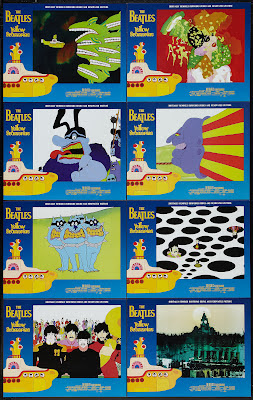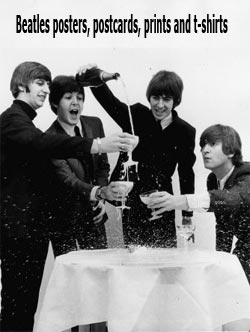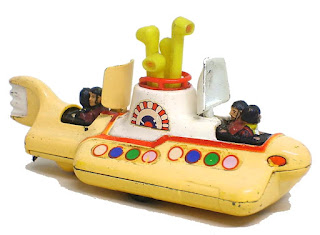"Yellow Submarine" is back with a vengeance. And it is not quite the film you may remember. The original mono soundtrack has been replaced with six-channel Surround Sound using a system called Dolby 5.1, and includes newly remixed versions of the Beatles' songs. It also includes the scene in which the Beatles sing "Hey Bulldog," a sequence that was deleted after the earliest screenings to quicken the pace of the film's final reel.
Getting there
The idea of renovating "Yellow Submarine" occurred to Bruce Markoe, the vice president of feature postproduction at MGM/UA, in 1995, when he played the film for his 5-year-old daughter. She loved it, Mr. Markoe said; but as a more critical viewer, he was disappointed that the colors were not as dazzling as he remembered them and that the soundtrack was flat by modern standards.
"I thought, 'We have something valuable here, something that a couple of generations haven't seen,' " he said. "I also thought that this was a film that cried out for upgrading with today's technology. So I went to John Calley, who was the president of the company at the time, and pitched him the idea of renovating the film for rerelease."
Mr. Markoe was told he could proceed once the legal problems were settled. That took a year. It took nearly as long for Mr. Markoe to get Apple to agree to allow the Beatles' music to be remixed for Surround Sound from the master tapes. In recent years, as the 60's recordings by the Byrds, the Who, the Kinks and other bands have been remixed and remastered to take new technologies into account, the Beatles have generally insisted that their music be left alone. In his meetings with Neil Aspinall, the chief executive at Apple, Mr. Markoe argued that simply replacing the mono recordings on the soundtrack with the stereo versions available on CD was not the best option.
"I told Neil that audiences are used to 5.1 digital sound in the movies now," Mr. Markoe said, "and that while we could spread out the stereo mixes for 5.1, it would compromise the recordings. I think that was the key, because the Beatles never liked to settle for compromises. Neil said we could go ahead, with the understanding that if the Beatles didn't approve the new mixes, we couldn't use them."
 |
| The 1968 lobby cards |
The remixing
The audio remixing got under way in October 1997 with Peter Cobbin, a staff engineer at EMI's Abbey Road Studios in London, at the remixing desk. Mr. Cobbin's task was inherently contradictory: the songs had to sound much as they originally did, yet the new mixes had to take advantage of the six-channel capability.
"A very detailed kind of attention was needed to make sure that everything was put back the same," Mr. Cobbin said of his mixes. "As you're probably aware, there are many takes of a song, and even within the take that was used for the record, there may be guitar solos or vocal harmonies that were not used. So a lot of time was spent seeing that the right elements were used."
Complicating matters further was the recording technique that the Beatles used between 1965 and 1968, when the songs on the "Yellow Submarine" soundtrack were recorded. Using the four-track equipment available at the time, the Beatles tended to fill all the four tracks with the basic skeleton of a song -- drums, bass and guitar, for example -- and then copy them on to a single track on a second reel of tape. They would then add vocals, solos and other embellishments on the remaining three tracks. When their ideas grew more complicated, they repeated this process until they had filled the tracks on three or four tapes.
There were trade-offs in this method: once the earliest tracks were mixed, copied and augmented, there was no way to reconsider the balances. And every time a copy was made, the sound quality was degraded. But EMI kept all of its Beatles session tapes, and using digital multitracking equipment, Mr. Cobbin was able to transfer the unmixed component tracks into a computer and remix them with a freedom that the Beatles and their producer, George Martin, did not have in the 60's.
"Eleanor Rigby," heard early in the film, is one of the simpler examples of what Mr. Cobbin was able to do.
"That was recorded with a string octet, laid out in a fairly traditional manner," he said. "Because the strings were recorded on all four tracks, they had to be bounced to mono for Paul to do his vocals. I had the four string tracks, so I could pan them the way the players were seated. And then, when you use the rear speakers for ambience, you do get the feeling that you're inside the stereo image, much more than if you have the strings coming out of one speaker."
Many of Mr. Cobbin's remixes have a revelatory freshness that even Beatles purists may find surprising. The vocal harmonies that open "Nowhere Man," for example, now envelop the listener; on the original stereo recording, the vocals were on one channel and the instruments on the other. The delicate percussion in "All Together Now," buried in the original recording, has a presence that gives the song a more complex, tactile texture. And "Only a Northern Song," never before released in stereo, has become a kaleidoscopic welter of sound.
The mixes passed the Beatles' audition, as well.
"Ah, it was great," Mr. Starr said of the 1998 session at which he and Mr. McCartney heard the Surround Sound mixes for the first time. "We're listening and saying, 'What is that?' Because you hear all these sounds that we made in the studio, but they all got buried. It's so lively."
 |
| The 1999 lobby cards |
The rest of the soundtrack
While Mr. Cobbin was working on the songs in London, Ted Hall, at Pacific Ocean Post (POP) Sound, and Greg Kimble, at POP Video, both in Santa Monica, Calif., revamped other elements of the film. Mr. Hall's domain was the rest of the soundtrack -- dialogue, sound effects and Mr. Martin's orchestral score. A suite from Mr. Martin's score had been included on the original "Yellow Submarine" soundtrack album and where possible, Mr. Hall replaced the mono soundtrack recording with the album version, which is in stereo.
"The stereo recording was not from the original scoring date for the film," Mr. Hall said. "He rerecorded it for the album several months later, so the arrangements are a little different, and a lot of the music wasn't included. But it sounded good and I wanted to use it. That meant that there are stretches that are eight bars in stereo and eight bars in mono. The challenge was to make it seamless."
Mr. Hall also removed clicks, pops, hiss and other noises from the soundtrack. He assembled an effects library by recording each of the film's roughly 300 sound effects separately, and enhancing some by adding bass, reverberation or other forms of processing. A few touch ups were necessary. In one scene, the Beatles are seen applauding, but there was no applause on the original soundtrack. Mr. Hall and Mr. Markoe recorded some themselves. Mr. Hall also supplied a burp for one of the Blue Meanies.
When he transferred the effects to the new soundtrack, the Surround Sound system allowed him to think spatially: now when the Flying Glove menaces the people of Pepperland, it can be heard flying around the theater, and the Blue Meanies' missiles seem to move across the screen.
The film restoration
Mr. Kimble worked on the film itself. Mr. Markoe had found an original negative for all five reels of the film, and an interpositive -- an intermediate copy made from the negative -- of the last three reels only. The interpositive was in good enough shape to use, after substantial cleaning and color correcting. But a new interpositive had to be made for the first two reels, which account for 40 of the film's 90 minutes. Before doing that, the negative, which Mr. Kimble described as "dirty, beat up and scratched," had to be scanned into the computer -- a process that took 340 hours -- and restored.
"There were tears to repair, crooked splices to fix and the colors had faded at different rates over the years," Mr. Kimble said. "Reds had become brown, whites had yellowed. In the opening titles, there are white letterings on a black background, but the black had become cyan. The color had to be corrected digitally. Other problems -- frames that someone had forgotten to color, or where there was dirt or a scratch -- had to be painted by hand. We went through the film frame by frame."
Creating a new print took about six months, and by the time the film and its soundtrack were reconciled, MGM/UA had spent about $600,000, more than double Mr. Markoe's original budget.
Okay, that was the 1999 restoration, so what have they done for 2012?
 |
| 2012 lobby cards set |
4K
According to the official press release, the film has been restored in 4K digital resolution by the Triage Motion Picture Services team led by Paul Rutan Jr. If you're as keen an enthusiast about the Beatles films as I, you will recall that Mr Rutan jr was also the man behind the mid-nineties restoration of the "A Hard Day's Night" and "Help!" films. The press release goes on to say that "Due to the delicate nature of the hand-drawn original artwork, no automated software was used in the digital clean-up of the film’s restored photochemical elements. This was all done by hand, frame by frame." 4K is an emerging standard for resolution in the digital medium, so named for its 4,000-pixel horizontal resolution. And there are currently no television sets on the market who supports this yet, but there will be later this year.
On June 5, the film will be reissued on DVD (and I'm still not sure if this sentence means that the 1999 DVD will just be duplicated) and make its Blu-Ray debut in a brand-new transfer (that will have to be a new transfer, because of the higher resolution on Blu-ray discs). That same day, the 1999 Yellow Submarine Songtrack CD will also see a remastered reissue. Of course, I would like to be able to enjoy the songtrack in surround sound, as my audio set-up allows for this, so a mere re-release doesn't quite do it for me, it would have to be a SACD or DVD-A release. Am I asking too much? And I know I'm not going to get it.
































2 comments:
Thats my video! Enjoy!
Post a Comment